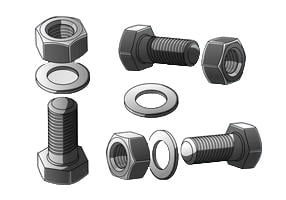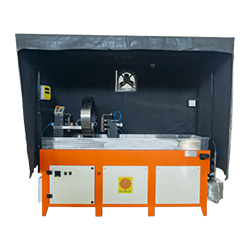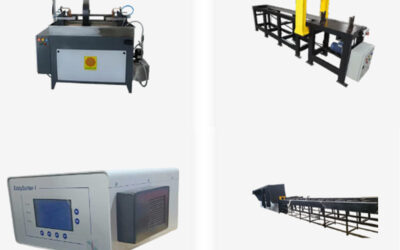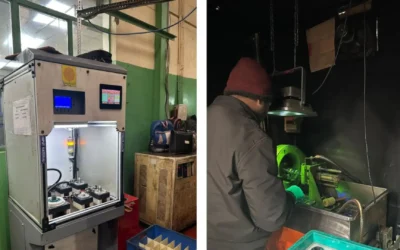
Fasteners consist of two parts, the nut & the bolt. The testing methods for both of them are different and are explained in the following sections.
MPI of Bolts
A bolt needs to be magnetized in two directions perpendicular to each other. A circular magnetic field is used to detect longitudinal flaws in the part.
Circular magnetic field is generated by passing a current through the length of the bolt.
Calculation of head shot current is done as per the formula given in ASTM standards.
Head Shot Current = 20 X Diameter(mm)
In the above formula, the diameter should be taken as diameter of the threaded portion
Longitudinal magnetic field, required for detection of transverse flaws is generated by using an encircling coil.
Formula for calculation of coil current

In the above formula, the diameter should be taken as the diameter of the threaded portion of the bolt.
For bolt having length >=80mm: Ahorizontal bench type machine is used to perform magnetic particle testing. The bolt is placed on the steady rollers fitted on the head & tailstock of the machine. A pneumatically operated arrangement is used to clamp the bolt from both ends. Pneumatic clamping ensures that there is no sparking when high current is passed through the bolt. Use of braided copper pads is also recommended to eliminate arcing sparks
For smaller bolts:A vertical bench type machine is used. The bolt is placed in vertical position on a fixture. This fixture is placed inside a coil. A pneumatically operated mechanism clamps the bolt from the top.
MPI of Nuts
Nuts are tested using a horizontal bench type machine. Several nuts (5-10) are loaded on a copper rod of approx. 20% lesser diameter smaller than the inside diameter of the nut. This copper rod is placed between headstock & tailstock. Current is passed through the copper rod.
Calculation of head shot current is done as per the formula given in ASTM standards.
Head Shot Current = 20 X Diameter(mm)
In the above formula, the diameter should be taken as outer diameter of the nut.
This currentwill generate a circular magnetic field in the nuts. Longitudinal defects can be checked using this magnetization.
To detect transverse defects, we need to create a longitudinalfield.An encircling coil is used for this purpose.
Formula for calculation of coil current

In the above formula, for the purpose of simplicity of calculations, the following assumptions can be made.
L= Length of each nut X Number of Nuts
D= Outer diameter of Nut-Inner Diameter of Nut
Testing Procedure for conventional machines
- Clean up & dry the nut/bolt’s surface before inspecting.
- The boltor the central conductor is placed on the machine.
- Now apply magnetic solution bath to the nut/bolt.
- Press the ‘Cycle Start’ button.
- The bolt/central conductor automatically gets clamped.
- Stop the flow of bath.
- Now, the current passes through the bolt or the central conductor.
- It shows up on the digital metering unit.
- The part automatically gets de-clamped.
- Inspect the nut/bolt under UV light for longitudinal defects. Rotate on steady rollers.
- Now, again apply bath to the job.
- Press the ‘Cycle Start’ button.
- Stop the flow of bath.
- Now the current passes through the coil.
- It shows up on the digital metering unit.
- Inspect the nut/bolt under UV light for transverse defects. Rotate on Rollers
- Demagnetize
Testing Procedure for Multidirectional machines
- Clean up & dry the nut/bolt’s surface before inspection
- Place the boltor central conductor on the steady rollers.
- Now apply a bath to the nut/bolt.
- Press the ‘Cycle Start’ button.
- The boltor central conductor will automatically get clamped.
- Stop the flow of the bath.
- Now the current will pass through the boltor central conductor & the coil in multidirectional mode.
- It will show up on the digital metering unit.
- The part will automatically get de-clamped.
- Inspect the nut/bolt under UV light for defects in all directions. Rotate on rollers.
- Demagnetize
suitable products
Standard MPI Machines
Engineered for precision and efficiency, the Standard Bench Type Magnetic Particle Testing Machine is suitable for entry level testing.
PLC Controlled MPI Bench
With PLC Controlled bench type Magnetic Particle Inspection Machine, you can accurately control the process parameters for reilable results.
Multidirectional MPI Bench
The ultimate solution for robust non-destructive testing, this machine offers multi-directional magnetization for inspection in all directions in one shot..
Demagnetizers
Demagnetizers stand as a key tool in maintaining excellence in production, with the flexibility to handle different materials and magnetism levels, coupled with energy-efficient and user-friendly design.
DIVE DEEPER: GET YOUR HANDS ON OUR PRODUCT BROCHURE!
Explore More, Discover Better!
- In-Depth Details
- Product Insights
- Expert Recommendations
Download Our Brochure Now!
Blogs
Magnetic Particle Testing Equipment: A Vital Tool for Quality Control in India
In today's fast-paced industrial landscape, ensuring the integrity and reliability of materials is critical. From aerospace and automotive industries to oil and gas, the safety of infrastructure and equipment is non-negotiable. One of the most trusted non-destructive...
The Essential Role of Magkraft’s MPI Products in Non-Destructive Testing
In the realm of Non-Destructive Testing (NDT), Magnetic Particle Inspection (MPI) stands out as a highly effective method for detecting surface and near-surface defects in ferromagnetic materials. MPI products are crucial components in this process, enabling...
Addressing Common Challenges in NDT: Solutions by Magkraft
Non-destructive testing (NDT) is critical in ensuring the integrity and reliability of materials and components across various industries. However, like any technical field, NDT has challenges that can impact inspection outcomes and efficiency. In this article, we'll...








